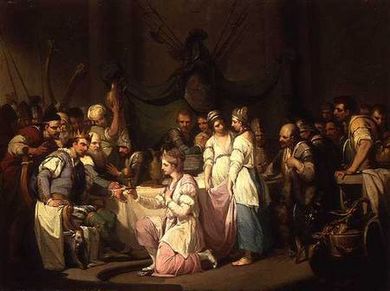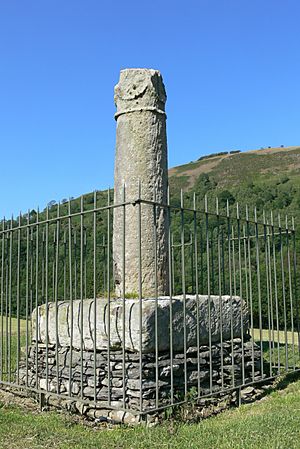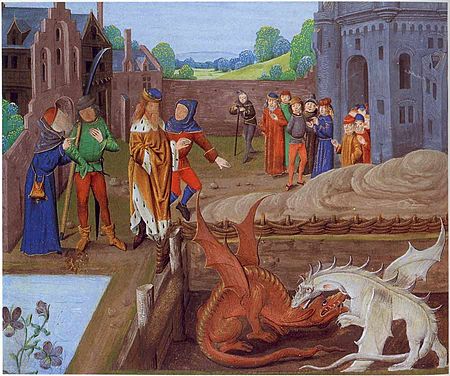Vortigern facts for kids
Vortigern (pronounced VOR-ti-jern) was a powerful leader in Britain during the 400s AD. This was a time when the Roman Empire was leaving Britain, and the land was facing attacks from groups like the Picts and the Scots. Some historical writings suggest Vortigern was a king of the Britons, or at least a very important ruler. However, historians still debate if he truly existed and much of what we know about him comes from old stories.
One famous story says that Vortigern invited Hengist and Horsa, leaders of the Saxons, to help him fight off invaders. But these Saxon allies later turned against him, leading to big changes in Britain, including the start of the Kingdom of Kent. It's said that Vortigern eventually sought safety in North Wales.
Contents
Ancient Stories About Vortigern
Many old texts mention Vortigern, giving us different ideas about his life and actions. These stories help us understand how people in the past viewed this important figure.
Gildas's Account
A writer named Gildas, who lived in the 500s, wrote a book called De Excidio et Conquestu Britanniae (which means On the Ruin and Conquest of Britain). In his book, Gildas talks about a "proud ruler" who made the mistake of inviting the "fierce Saxons" to settle in Britain.
Gildas says a small group of Saxons first arrived and were given land in the east of the island. This group then invited more of their people to join them. Eventually, the Saxons demanded more supplies. When their demands were refused, they broke their agreement and attacked the lands of the Romano-British people. Gildas describes how the Saxon raids spread "from sea to sea," burning almost the entire island.
Gildas doesn't clearly name this ruler as Vortigern in most copies of his work. However, some older copies do use the name "Vortigern." Gildas also mentions that the ruler was helped by a "Council" in inviting the Saxons. Gildas didn't call Vortigern evil, but rather "unlucky" and someone who made poor choices.
Gildas also included some interesting details that might have come from the Saxons themselves. He mentioned that the first group of Saxons arrived in three "keels," which was their word for war ships. He also wrote that a Saxon fortune-teller predicted they would rule Britain for 300 years and plunder it for 150 years.
Bede's Version of Events
Bede, a historian writing in the 700s, also wrote about Vortigern in his book Ecclesiastical History of the English People. Bede largely retold Gildas's story but added some new details.
Bede was the first to clearly name the "proud ruler" as Vortigern. He also named the Saxon leaders as Hengist and Horsa and said they came from the Saxons, Angles, and Jutes tribes. Importantly, Bede called Vortigern the king of the British people. Bede also gave a specific date for the Saxons' arrival, 449 AD, though historians now think this date might be an estimate.
The Historia Brittonum Stories
The Historia Brittonum (meaning History of the Britons) was likely written in the early 800s. This book tells many more stories about Vortigern and his family. It describes how Vortigern dealt with the Saxons and also mentions Saint Germanus of Auxerre.
Some of the stories in Historia Brittonum include:
- Saint Germanus: Tales about Saint Germanus, including one where he helps Vortigern's son.
- Vortigern's Family: Details about Vortigern's ancestors and his four sons: Vortimer, Pascent, Catigern, and Faustus.
- Saxon Land Deals: The story of how Vortigern first gave land on the Thanet to the Saxons in exchange for their help as soldiers. Then, he gave them more land in Kent after marrying Hengist's daughter. Later, the Saxons tricked and killed many British leaders at a banquet, forcing Vortigern to give them even more land in Essex and Sussex.
- The Dragons of Dinas Emrys: A famous tale about Ambrosius Aurelianus and two dragons found beneath Dinas Emrys. Vortigern tried to build a fortress there, but it kept falling down. His wise men told him to sacrifice a boy who had no father. This boy, Ambrosius, revealed that two dragons were fighting beneath the ground, causing the fortress to collapse.
The Historia Brittonum also mentions four battles in Kent where Vortigern's son, Vortimer, led the Britons against the Saxons. It claims that the Saxons were driven out of Britain but returned later after Vortimer died, invited back by Vortigern.
The Anglo-Saxon Chronicle
The Anglo-Saxon Chronicle is a collection of historical records from England. It lists dates and places for four battles between Hengist and Horsa's Saxons and the Britons in Kent. Vortigern is mentioned as the British commander only in the first battle. The later battles simply refer to the opponents as "British" or "Welsh." The Chronicle says the Saxons first landed at Wippedsfleot (now Ebbsfleet) around 465 AD. Vortigern is last mentioned in the year 455 AD.
The parts of the Chronicle about the 400s were written down in the 800s, possibly during the time of Alfred the Great. These early records might have come from old oral stories or poems.
Geoffrey of Monmouth's Story

Geoffrey of Monmouth, writing in the 1100s, created the most famous version of Vortigern's story in his book Historia Regum Britanniae (History of the Kings of Britain). This book is considered a "pseudohistory" because it mixes facts with legends.
In Geoffrey's story, Vortigern convinces Constans, the older brother of Aurelius Ambrosius and Uther Pendragon, to leave his monastery and become king. Constans was a weak king, and Vortigern truly held the power. Vortigern eventually arranged for Constans to be killed by Picts.
Geoffrey also names Hengist's daughter as Rowena. After Vortigern marries her, his own sons rebel against him. Geoffrey's story, like the Historia Brittonum, says that Vortigern's son Vortimer briefly became king but Vortigern took the throne again after Vortimer died.
Pillar of Eliseg's Clues

The Pillar of Eliseg is an old stone cross from the mid-800s located in Llangollen, Wales. An inscription on the pillar mentions "Guarthi[gern]," which is believed to be Vortigern. The pillar also states that he was married to Sevira, the daughter of Magnus Maximus, a Roman emperor. This pillar connects Vortigern to the royal family of Powys, who built the cross.
Vortigern: A Name or a Title?
Some historians have wondered if "Vortigern" was a title rather than a personal name. In the ancient British language, "Vortigern" literally means "Great King" or "Overlord." It's made up of two parts: "*wor-" meaning "over" or "super," and "*tigerno-" meaning "king" or "lord."
However, the "tigerno" part was commonly used in personal names, like in "Kentigern." Also, there's no evidence that "Vortigern" was a common title. In fact, a similar name, "Foirtchern," was a common personal name in ancient Ireland. This suggests that Vortigern was most likely a personal name, not just a title.
Vortigern in Local Legends
Many places in Britain are linked to Vortigern through local stories.
- Nant Gwrtheyrn: A valley in North Wales called "Vortigern's Gorge" is named after him. Until recently, it had a small mound known as "Vortigern's Grave" and a ruin called "Vortigern's Fort."
- Other Fortifications: Other forts and ancient sites are also connected to Vortigern, including places in Gwynedd, Wiltshire, Powys, and Herefordshire. These include Dinas Emrys (where the dragons were found), Old Sarum, and even Stonehenge.
Vortigern in Later Art and Plays
Vortigern's story remained popular long after the Middle Ages, especially in Britain.
- Plays: He is a main character in two plays from the 1600s: The Birth of Merlin and Hengist, King of Kent.
- Paintings: His meeting with Rowena became a popular subject for artists in the 17th and 18th centuries, like William Hamilton's painting Vortigern and Rowena.
- Literary Forgery: One of Vortigern's most famous appearances was in a play called Vortigern and Rowena in 1796. It was first presented as a lost work by William Shakespeare, but it was soon discovered to be a fake written by William Henry Ireland. The play was so poorly written that it was laughed off stage and never performed again.
Images for kids
-
Vortigern and Rowena by William Harvey



